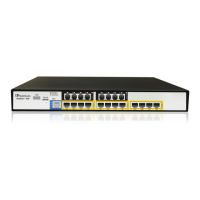For example, if four T1 trunks on a device are configured as a single NFAS group with
Primary and Backup T1 trunks that is used with a DMS-100 switch, the following
parameters should be used:
NFASGroupNumber_0 = 1
NFASGroupNumber_1 = 1
NFASGroupNumber_2 = 1
NFASGroupNumber_3 = 1
DchConfig_0 = 0 ;Primary T1 trunk
DchConfig_1 = 1 ;Backup T1 trunk
DchConfig_2 = 2 ;B-Channel NFAS trunk
DchConfig_3 = 2 ;B-channel NFAS trunk
If there is no NFAS Backup trunk, the following configuration should be used:
ISDNNFASInterfaceID_0 = 0
ISDNNFASInterfaceID_1 = 2
ISDNNFASInterfaceID_2 = 3
ISDNNFASInterfaceID_3 = 4
ISDNIBehavior = 512 ;This parameter should be added because of
;ISDNNFASInterfaceID coniguration above
NFASGroupNumber_0 = 1
NFASGroupNumber_1 = 1
NFASGroupNumber_2 = 1
NFASGroupNumber_3 = 1
DchConfig_0 = 0 ;Primary T1 trunk
DchConfig_1 = 2 ;B-Channel NFAS trunk
DchConfig_2 = 2 ;B-Channel NFAS trunk
DchConfig_3 = 2 ;B-channel NFAS trunk
23.6.3 Creating an NFAS-Related Trunk Configuration
The procedures for creating and deleting an NFAS group must be performed in the correct
order, as described below.
To create an NFAS Group:
1. If there’s a backup (‘secondary’) trunk for this group, it must be configured first.
2. Configure the primary trunk before configuring any NFAS (‘slave’) trunk.
3. Configure NFAS (‘slave’) trunks.
To stop / delete an NFAS Group:
1. Stop or delete (by setting ProtocolType to 0, i.e., 'None') all NFAS (‘slave’) trunks.
2. Stop or delete (by setting ProtocolType to 0, i.e., 'None') the backup trunk if a backup
trunk exists.
3. Stop or delete (by setting ProtocolType to 0, i.e., 'None') the primary trunk.
Notes:
• All trunks in the group must be configured with the same values for trunk
parameters TerminationSide, ProtocolType, FramingMethod, and
LineCode.
• After stopping or deleting the backup trunk, delete the group and then
reconfigure it.

